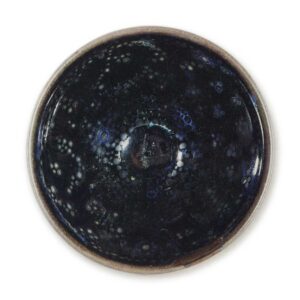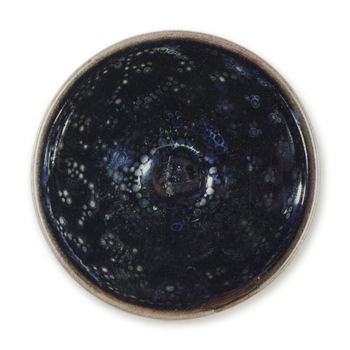

major landmarks
National Treasure
Collection: Ryuko-in Temple
Height: 6.5-6.6cm
Mouth diameter: 12.0-12.1cm
Outer diameter of the base: 3.8cm
Height of the same: 0.4cm
This is a great masterpiece that has been handed down as a great masterpiece together with Inaba Tenmoku and Yohhen from the Fujita Museum of Art, and is designated as a national treasure. This tea bowl was kept as a temple treasure in Daitoku-ji Temple, the old head temple of Daitoku-ji Temple (the family temple of Tsuda Munenori), together with the calligraphy of Muinori.
The clay is almost the same as that of the other two national treasures, but it is a little more bluish-black than that of the Fujita Museum. The bowl seems to have been turned on a heavy and fast potter’s wheel, and the shape of the bowl is clean and neat, and the grinding around the side of the base is superb. The outer ring of the base has a two-tiered appearance similar to that of a bamboo joint base, a phenomenon that is not often seen in other Tenmoku wares.
The glaze and the appearance of yohen are similar to those of the Fujita Art Museum. In other words, the under glaze and the over glaze are well fused in the thicker part of the glassy dark black glaze, and the surface is covered with yohane or rabbit’s-eye cup patterns. The surface is covered with a silvery oil droplet, which interferes with the iridescent film.
However, at the mouth rim, where the glaze layer is inevitably thin, the glaze color is pale and the yohen phenomenon does not occur, so the underlying earthen color is reflected in the iron color. While the interior surface undergoes various kinds of yohening, the exterior surface does not. The glaze tone is almost the same, but the yōhening may not occur easily due to the degree of fire and other factors. On one surface, however, there is a silver, reticulated, silvery, and penetrating pattern, which is subtly intertwined with the iris film and emits a dull bluish light. At this point, it is difficult to say what these intrusions are or how they occurred.
There is a fine Susan Susan running along the outer rim of the bowl, which looks silvery under the light. Except for a small repair of lacquer on the mouth rim, the rest of the piece is in perfect condition.
It is said that Yohantenmoku might have been made in a different kiln from the general type of jianzan, but this is also unknown at present. Dr. Plummer’s survey of the Jian kiln site did not find any Yohhen shards, but it is difficult to conclude that this type of Yohhen Tengmoku was not made in the Jian kiln because it is a very rare and accidental occurrence.
(Sato Masahiko)



